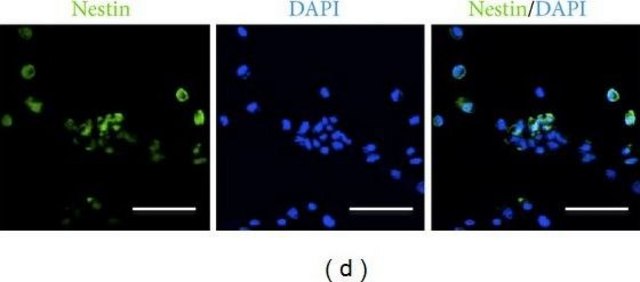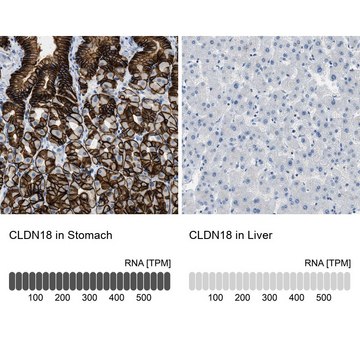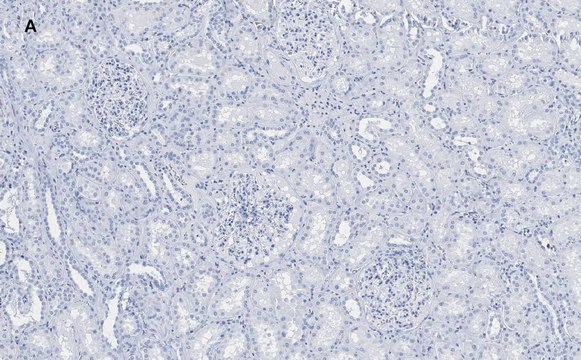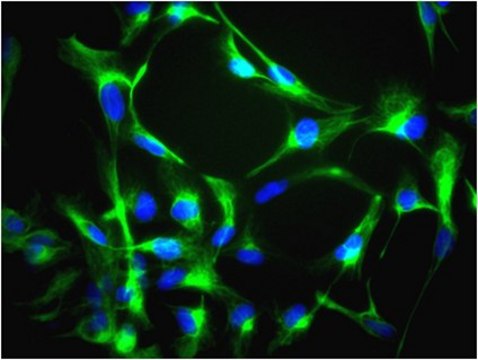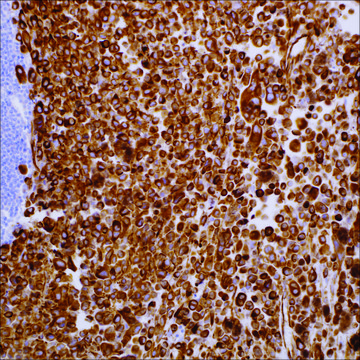MAB5326C3
Anti-Nestin Antibody, clone 10C2, Cy3 conjugate
clone 10C2, from mouse, CY3 conjugate
Synonym(s):
Nestin10c2, NES, Nbla00170, FLJ21841
Sign Into View Organizational & Contract Pricing
Select a Size
All Photos(1)
Select a Size
Change View
About This Item
UNSPSC Code:
12352203
eCl@ss:
32160702
NACRES:
NA.41
Recommended Products
General description
Nestin, a large intermediate filament protein (class Type VI) expressed during development and in myotendinous and neuromuscular junctions. Nestin expression is restricted, typically disappearing by E18. Nestin is thought to be a reasonable neuronal marker; however, recent studies have found nestin expression in other cell types such as endothelial cells {Folia Biologica, 44(5):155, 1998}. Nestin identifies the most primitive neuroepithelium but also identifies many other embryonic tissues, so it is not specific for CNS. Nestin expression is seen in almost all GBMs (Glioblastoma mulitformes) and many melanomas (both primary and metastatic) but not in any metastatic carcinoma.
Specificity
This antibody recognizes human Nestin. Antibody is not reactive with rat or mouse Nestin protein.
Immunogen
Fusion protein corresponding to human Nestin.
Application
Detect Nestin using this Anti-Nestin Antibody, clone 10C2, Cy3 conjugate validated for use in ICC.
Research Category
Stem Cell Research
Neuroscience
Stem Cell Research
Neuroscience
Research Sub Category
Neurofilament & Neuron Metabolism
Neuronal & Glial Markers
Neurofilament & Neuron Metabolism
Neuronal & Glial Markers
Quality
Evaluated by Immunocytochemistry in human RNcell CX neural stem cells (SCC007). Immunocytochemsitry Analysis: A 1:100 dilution of this antibody detected Nestin in human RNcell CX neural stem cells (SCC007).
Target description
The uncojugated parent antibody (Catalog No. MAB5326) has an observed MW at 200-220 kDa
Physical form
Protein A purified
Purified mouse monoclonal IgG1 conjugated to Cy3 in PBS with 0.1% sodium azide and 15mg/ml BSA.
Storage and Stability
Maintain refrigerated at 2-8ºC protected from light in undiluted aliquots for up to 6 months from date of receipt.
Analysis Note
Control
RNcell CX neural stem cells (SCC007).
RNcell CX neural stem cells (SCC007).
Disclaimer
Unless otherwise stated in our catalog or other company documentation accompanying the product(s), our products are intended for research use only and are not to be used for any other purpose, which includes but is not limited to, unauthorized commercial uses, in vitro diagnostic uses, ex vivo or in vivo therapeutic uses or any type of consumption or application to humans or animals.
Not finding the right product?
Try our Product Selector Tool.
Storage Class
12 - Non Combustible Liquids
wgk_germany
WGK 2
flash_point_f
Not applicable
flash_point_c
Not applicable
Certificates of Analysis (COA)
Search for Certificates of Analysis (COA) by entering the products Lot/Batch Number. Lot and Batch Numbers can be found on a product’s label following the words ‘Lot’ or ‘Batch’.
Already Own This Product?
Find documentation for the products that you have recently purchased in the Document Library.
C A Messam et al.
Experimental neurology, 161(2), 585-596 (2000-02-25)
The presence of the intermediate filament protein nestin has been the predominant marker used to describe stem and progenitor cells in the mammalian CNS. In this study, a 998-bp fragment in the 3' region of the nestin mRNA was cloned
Jinte Middeldorp et al.
Development (Cambridge, England), 137(2), 313-321 (2009-12-31)
A subpopulation of glial fibrillary acidic protein (GFAP)-expressing cells located along the length of the lateral ventricles in the subventricular zone (SVZ) have been identified as the multipotent neural stem cells of the adult mammalian brain. We have previously found
Raelene Endersby et al.
Cancer research, 71(12), 4106-4116 (2011-04-22)
The AKT family, comprising three highly homologous kinases, is an essential mediator of the PTEN/PI3K pathway, which is deregulated in many human cancers. A thorough understanding of the specific activities of each isoform in normal and disease tissues is lacking.
The endocannabinoid system promotes astroglial differentiation by acting on neural progenitor cells.
Tania Aguado et al.
The Journal of neuroscience : the official journal of the Society for Neuroscience, 26(5), 1551-1561 (2006-02-03)
Endocannabinoids exert an important neuromodulatory role via presynaptic cannabinoid CB1 receptors and may also participate in the control of neural cell death and survival. The function of the endocannabinoid system has been extensively studied in differentiated neurons, but its potential
Teresa Coccini et al.
Current protocols, 2(4), e423-e423 (2022-04-27)
Neurotoxicity (NT) testing for regulatory purposes is based on in vivo animal testing. There is general consensus, however, about the need for the development of alternative methodologies to allow researchers to more rapidly and cost effectively screen large numbers of
Our team of scientists has experience in all areas of research including Life Science, Material Science, Chemical Synthesis, Chromatography, Analytical and many others.
Contact Technical Service


